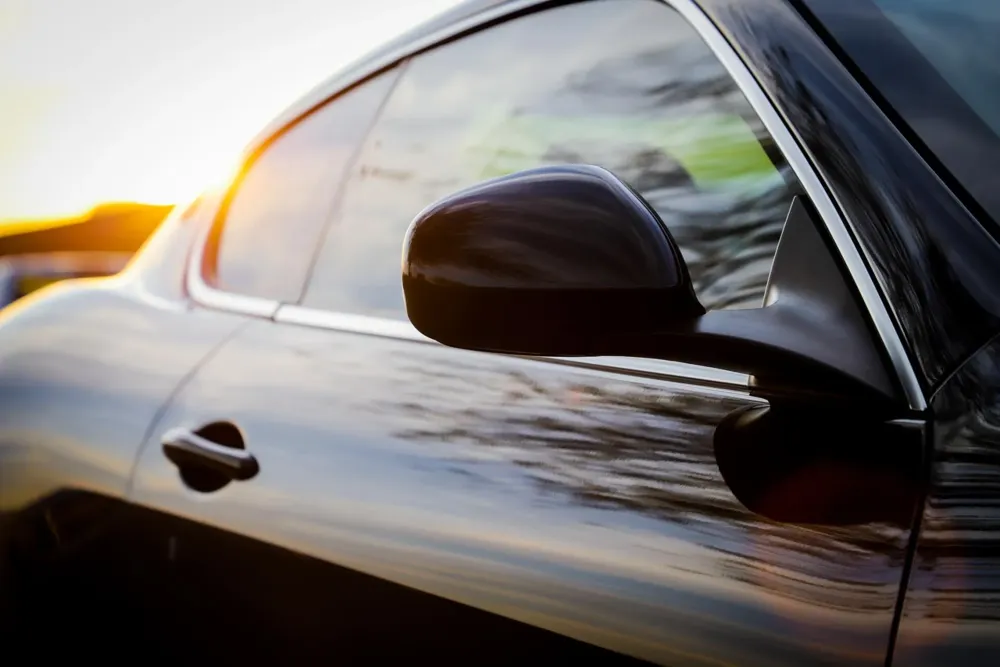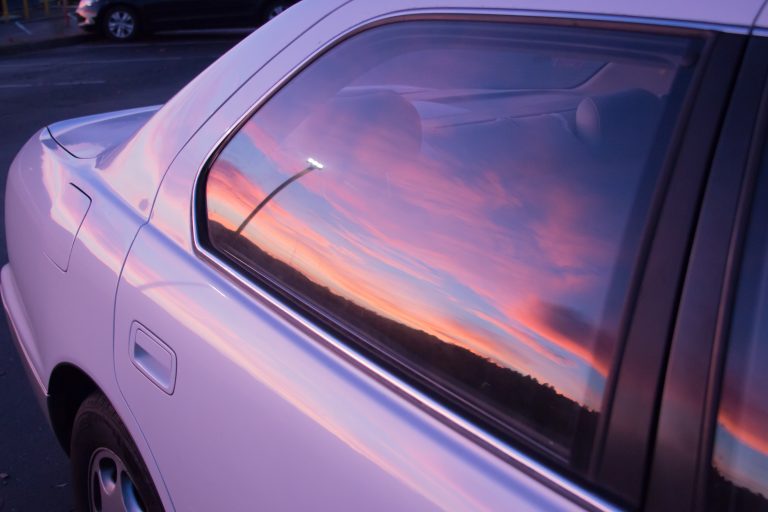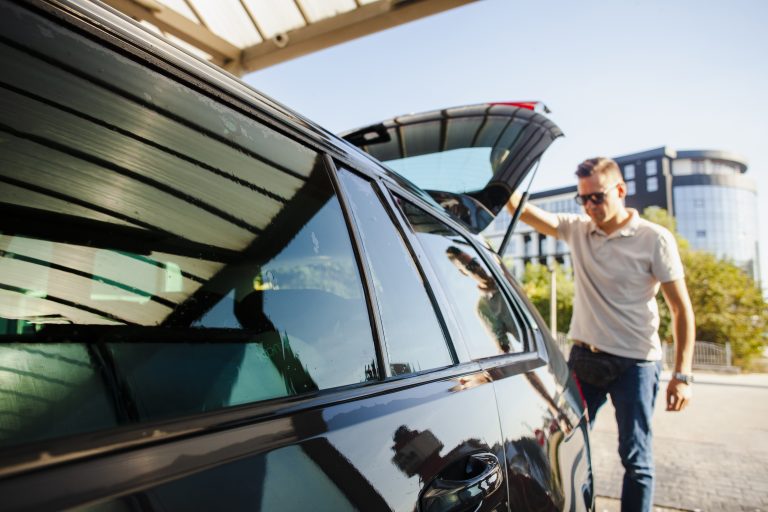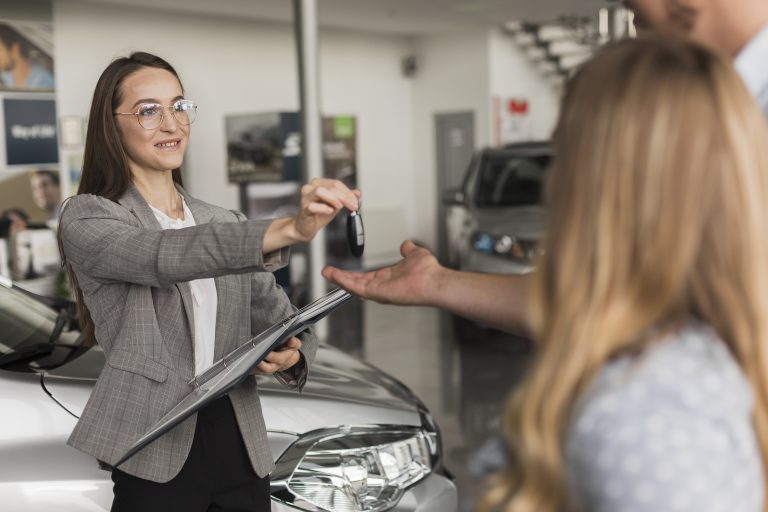
When it comes to window tinting, car owners have more options today than ever before. Two of the most popular choices are dyed window tint and ceramic window tint. Both types serve the basic purpose of darkening your windows for privacy and aesthetics, but they differ significantly in performance and longevity. So, ceramic vs. dyed tint: which one is worth it? In this article, we’ll compare these two tint types in terms of heat rejection, UV protection, longevity, appearance, and cost. By the end, you’ll have a clear understanding of the pros and cons of each, and which might be the better investment for your vehicle.
Local Expertise: At 586 Tint Factory – a Clinton Township-based business serving Macomb, Oakland, and Wayne Counties – we’ve installed thousands of tinted windows. We pride ourselves on quality service, years of experience, and customer satisfaction. We know what works best for Michigan drivers, and we’re here to share our expertise. Let’s dive into the comparison!
Heat Rejection Performance
One of the biggest differences between dyed and ceramic tint is how well they keep your car cool. Michigan summers can get hot and sunny, so heat rejection is a key factor.
- Dyed Tint: Dyed window film provides a basic level of heat reduction by absorbing some of the sunlight’s energy. This can take the edge off a hot day, but it’s not the most effective solution for cooling. Standard dyed tints lack the advanced infrared-blocking technology found in higher-end films. In fact, regular dyed tint offers only limited heat rejection – it can slightly reduce the sun’s glare and heat, but it won’t dramatically cool your cabin in sweltering conditions. If your main goal is to reduce interior temperatures, dyed tint may leave you wanting more relief on extremely hot days.
- Ceramic Tint: Ceramic window tint is the gold standard for heat rejection. These films are infused with nano-ceramic particles that block a significant portion of solar heat, especially the infrared radiation (IR) that is largely responsible for that burning hot feeling inside a car. A high-quality ceramic tint can reject a much higher percentage of heat compared to dyed film. In fact, some premium ceramic films block up to 90–98% of infrared heat, resulting in a noticeably cooler car interior. This means even on a blistering summer afternoon, a car with ceramic tint will stay more comfortable, putting less strain on your air conditioning.
Heat Rejection – Bottom Line: If keeping your car cool is a top priority, ceramic tint clearly outperforms dyed tint in this category. Dyed tint does help somewhat, but ceramic films provide far superior heat rejection, making a real difference in cabin comfort on hot days.
UV Protection
Protecting against harmful ultraviolet (UV) rays is another major benefit of window tint. UV rays can cause skin damage (even through car windows) and fade your vehicle’s interior. Let’s compare how dyed and ceramic tints stack up here:
- Dyed Tint: Despite being a basic film, most quality dyed tints today offer excellent UV blocking. Dyed films are often engineered to block over 99% of UV rays, providing roughly the equivalent of SPF 500 for you and your passengers. This high UV rejection helps protect your skin from damage and keeps your upholstery, dash, and other interior surfaces from fading or cracking due to sun exposure. However, one caveat is that if the dyed film is of lower quality or degrades over time, its UV protection might diminish. Generally, though, any reputable dyed automotive film will advertise near-total UV blockage as a feature.
- Ceramic Tint: Ceramic films also block 99% (or more) of UV radiation, and they maintain that protection for the life of the tint. In fact, ceramic tints often have the highest UV protection ratings in the industry (some are rated at SPF 1000). This means whether you choose dyed or ceramic, you’re usually getting superb protection against UVA and UVB rays. One advantage of ceramic is that it achieves this UV shielding alongside superior heat rejection, whereas dyed films block UV but let more heat through. Both tint types will help prevent sun damage to your car’s interior and reduce your risk of sun exposure while driving, which is especially important for long trips or if you’re sensitive to sunlight.
UV Protection – Bottom Line: In terms of UV blocking, both dyed and ceramic tints are excellent, often stopping ~99% of harmful rays. Ceramic tint isn’t necessarily “more UV protective” than a good dyed film – both will keep you and your car’s interior safe from UV radiation. The real differentiator is that ceramic combines UV protection with much better heat rejection.
Longevity and Durability
How long your tint lasts and looks good is an important consideration. Here’s how dyed vs. ceramic compare when it comes to durability and longevity over the years:
- Dyed Tint: Standard dyed films are known to be the entry-level option, and one downside has historically been fading. Older or low-quality dyed tints often change color over time – for example, turning that unsightly purple or bubbling after years of sun exposure. Even high-quality dyed film, while improved, may eventually lose some depth of color after many years under harsh sunlight. Additionally, dyed tints are typically made of layers that include dye particles, which can break down. They also absorb heat (as mentioned), which can accelerate wear in extreme climates. That said, many modern dyed tints (like the premium ones we use at 586 Tint Factory) are much more color-stable than the cheap tints of decades past – they are designed not to fade or discolor quickly. Still, in general, you can expect a shorter lifespan from dyed film compared to more advanced tints. You might need to replace a dyed tint film after some years if it starts to fade, bubble, or delaminate. Most dyed tints come with a decent warranty, but it may not be as long as the warranty for ceramic films.
- Ceramic Tint: Ceramic window films are extremely durable and long-lasting. Because they contain ceramic particle technology instead of dyed layers, they are not prone to fading or color change at all. The color you see on day one is the color you’ll see years down the road – the film will stay just as dark (or light) as when it was installed. In addition, ceramic films are often constructed with higher-grade materials and scratch-resistant coatings, meaning they can stand up to the elements and daily use without bubbling or peeling. They typically come with long warranties (often lifetime warranties from manufacturers) due to their expected longevity. In short, ceramic tints last longer and maintain their performance over time better than dyed tints. You likely won’t have to worry about replacing your ceramic tint for the life of your vehicle ownership, assuming proper installation and care.
Longevity – Bottom Line: Ceramic tint wins on durability. Dyed tints can degrade or fade over the years (especially if they’re lower quality), whereas ceramic tints are built to last for the long haul without losing effectiveness. If you plan to keep your vehicle for many years, the extended lifespan of ceramic film can provide better value over time, as you won’t need to re-tint the windows due to aging film.
Appearance and Clarity
Looks are subjective, but there are some notable differences in the appearance and optical clarity of dyed vs. ceramic tints:
- Dyed Tint Appearance: Dyed window film gives a classic shaded look to your glass. It tends to have a non-reflective, matte finish from the outside, resulting in a smooth, dark appearance that many find sleek. It’s great for privacy – people will have a hard time seeing into your car, especially with darker shades, since dyed film primarily darkens the window. One potential downside is that lower-grade dyed tints may develop that mirrored or hazy look as they age (or have an initial slight reflectiveness), but quality dyed films generally maintain a clean black look (and as noted, avoid turning purple). Dyed tint does a good job reducing glare from the sun by dimming the light, but at very dark levels it can reduce night visibility from inside if you’re not careful in choosing the legal shade. Overall, dyed tints can make your car look cool and private with a charcoal or blacked-out window appearance. They pair well with many factory car window tints (for example, matching the look of factory-tinted rear windows on SUVs).
- Ceramic Tint Appearance: Ceramic tints are prized not just for performance but also for their optical clarity. From inside the car, ceramic films tend to offer a crisper, clearer view with less haze. Even with a darker shade, you’ll often notice that you can see the outside world more clearly and with less distortion or color cast than some cheap dyed films. From the outside, ceramic tint also looks fantastic; it tones down the light much like dyed tint, but usually without any mirror-like glare. (Unlike some metallic films or certain dyed films that can look reflective, ceramic films have no metal, so they maintain a non-mirrored, factory-style finish.) Another advantage is that ceramic tints come in various shades, including lighter VLT (Visible Light Transmission) levels that still block heat. This means you could opt for a relatively lighter tint (for style or legal reasons) and still get excellent heat rejection—your windows don’t have to be extremely dark to get the benefits. In terms of overall appearance, ceramic film often gives a higher-end look to the vehicle. It’s the kind of tint that looks elegant and upscale, complementing luxury cars and daily drivers alike. Both dyed and ceramic can look similar in darkness, but enthusiasts might notice ceramic films often have a slight reflective quality under some angles (less than metallic, but a tiny sheen due to the ceramic particles) – however, this is generally minimal. Most people will see that both types just look “tinted,” and the difference is how clear the view and color stability remains over time (ceramic staying superior in that regard).
- Signal Interference: It’s worth noting as a side point that neither pure dyed nor ceramic tints will interfere with electronic signals (such as GPS, mobile phone, radio, or tire-pressure monitors). The interference issue happens with metallic (metalized) tints, which use metallic particles. Some older or hybrid dyed tints had metallic content and could cause signal issues, but a true dyed film today is typically non-metallic. Ceramic films are also non-metal and explicitly designed to avoid signal interference. So, if you’re worried about your window tint messing up your navigation or smartphone reception, both dyed and ceramic are safe choices in that regard.
Appearance – Bottom Line: Both tint types will make your car look sleek and provide added privacy. Dyed tint offers a dark, non-reflective finish that many enjoy, while ceramic tint provides exceptional clarity and a high-end look without turning your windows into mirrors. Importantly, ceramic lets you achieve this look even with lighter shades that maintain more visibility. Neither will impede your electronic signals (unlike metallic tints). If you’re very particular about long-term appearance, ceramic’s resistance to discoloration means it will look new for years, whereas dyed could gradually lose some visual lustre after extensive sun exposure.
Cost Considerations
Cost is often the deciding factor when choosing window tint. Here’s how dyed vs. ceramic compare in terms of price and value:
Dyed Tint Cost:
- Dyed window film is the budget-friendly option. If you’re looking to tint your car windows without breaking the bank, dyed film will be the cheaper choice almost every time. It’s less expensive to manufacture and thus cheaper for installers to buy, and installation is typically straightforward. For customers, this means dyed tint can cost considerably less per window (or per job) than ceramic. It’s a great solution if you want the basic benefits of tint – privacy, glare reduction, some heat and UV reduction – at the lowest price. For many drivers, especially those on a tight budget or with an older vehicle, dyed tint provides the best bang for your buck upfront. You’ll still get a nice look and the standard protections, just without the high-performance extras. However, keep in mind the earlier points: dyed tint might not last as long. If a dyed film starts to fail after a few years, you may have to pay to remove and replace it. So its shorter lifespan can add hidden cost in the long run. Despite that, the initial affordability of dyed tint is hard to beat. It’s the go-to choice for an economical tint job.
Ceramic Tint Cost:
- Ceramic tint is a premium product, and it comes with a premium price tag. As the saying goes, “you get what you pay for.” Ceramic films are more complex to manufacture (with those nano-ceramic particles and multi-layer construction), and they deliver top-tier performance – thus they are significantly more expensive than dyed films. If you opt for ceramic tint, especially a high-end brand, expect to invest more money upfront for your tint installation. The cost might be anywhere from 2x to 3x the cost of dyed tint (general ballpark; exact pricing varies). For many car owners, the superior heat rejection, clarity, and longevity of ceramic film justify this higher price. You are paying for comfort (cooler car), protection (maximum UV and interior protection), and durability (film that won’t degrade). As a result, many customers find that ceramic is worth the cost, especially if they plan to keep their vehicle for a long time or truly want the best performance. It’s an investment in your car’s value and your personal comfort. Still, not everyone has the budget for ceramic tint right now, and that’s okay. You should choose what makes sense financially. One strategy some people use is to tint the front two windows in ceramic (where heat and UV on the driver/passenger are most critical) and do the rest in a less expensive film – but if possible, doing all windows in ceramic gives the full benefit. At 586 Tint Factory, we offer free estimates and can provide pricing options for both types so you can decide what fits your budget.
Cost – Bottom Line
Dyed tint is cheaper upfront – it’s the economical choice for basic tinting needs. Ceramic tint costs more initially, but brings added benefits. If budget is a big concern, dyed tint will get the job done at a fraction of the price. If you can afford the investment, ceramic tint’s performance and longevity can pay off in the long run, potentially saving you from re-tinting later and giving you a more comfortable driving experience
It really comes down to what you value and what you’re willing to spend for extra comfort and durability.
Pros and Cons of Each Tint Type
To summarize the comparison, here’s a quick rundown of the pros and cons of dyed vs. ceramic window tint:
Dyed Tint – Pros:
- Affordable: Typically the lowest cost option for window tinting, great for budget-conscious projects.
- Privacy & Glare Reduction: Provides a dark shaded look that improves privacy and cuts down glare from sunlight.
- UV Protection: Blocks a high percentage of harmful UV rays (usually ~99%), helping protect your skin and interior.
- No Signal Interference: Contains no metal, so it won’t interfere with GPS, radio, or cell signals (unlike metallic films).
- Decent Appearance: Offers a clean, dark aesthetic with a non-reflective finish; can closely match factory tints.
Dyed Tint – Cons:
- Limited Heat Rejection: Does not block as much infrared heat, so it’s less effective at cooling the car compared to ceramic.
- Fading Over Time: Prone to fading or discoloration with prolonged sun exposure; may turn purple or lose darkness over the years.
- Shorter Lifespan: Generally not as durable; might develop bubbles or peeling if the adhesive breaks down, meaning you could need a replacement film sooner.
- Value Over Time: While cheaper upfront, if you have to re-tint the car in a few years due to degradation, the costs can add up, potentially making it more expensive long-term.
- Less Premium: Lacks the high-tech features of ceramic; it’s the “standard” tint, which might be a downside if you’re seeking top performance.
Ceramic Tint – Pros:
- Superior Heat Rejection: Excellent at blocking heat, especially infrared rays – keeps your car significantly cooler on hot days.
- Maximum UV Protection: Blocks ~99% of UV rays (on par with or better than other films), safeguarding your skin and preventing interior fade.
- No Fading, Long Life: Color-stable and extremely durable – won’t fade or turn purple, and often lasts the lifetime of the vehicle without issues.
- Clarity and Comfort: Provides clear visibility and reduced glare from inside; you get tint benefits without impairing your view.
- No Signal Interference: Like dyed film, ceramic contains no metal, so all your electronic devices will work flawlessly.
- High-End Appearance: Gives a premium, sophisticated look to your car; available in various shades (including lighter tints that still perform well) for a customized style.
- Warranty: Many ceramic tints come with long warranties (often lifetime for the original owner) due to their longevity, adding peace of mind.
Ceramic Tint – Cons:
- Higher Cost: Significantly more expensive upfront than dyed tint. It’s an investment that not every budget can accommodate.
- Availability: Not every shop carries top-tier ceramic films or the specific brand you might want; however, 586 Tint Factory uses industry-leading ceramic films, so this isn’t an issue for our customers.
- Diminishing Returns for Some Users: If you only drive short distances or live in a mild climate, you might not experience dramatic benefits from the extra money spent – the difference may be more appreciated in extreme conditions. (Michigan sees both hot summers and cold winters, so heat rejection is very useful here on those sunny July days, whereas in a cooler region the gap might not feel as critical.)
- Installation Sensitivity: This isn’t exactly a con of the film itself, but ceramic films are high-end products that require professional installation to perform their best. You’ll want an experienced installer (like our team) to handle it, whereas some might attempt DIY with cheaper dyed film (not recommended in either case, but especially not for ceramic).
Trust the Experts at 586 Tint Factory
Choosing between ceramic and dyed tint comes down to your priorities – budget vs. performance. There is no one-size-fits-all answer, and that’s where consulting with a professional shop can help. At 586 Tint Factory, we offer both dyed and ceramic window tint options (as well as a mid-level carbon film) to suit different needs
Our team has over 70 years of combined industry experience and a track record of excellence (780+ five-star Google reviews) from customers across Macomb, Oakland, and Wayne Counties. We don’t cut corners – whether you choose an entry-level tint or the top-tier ceramic, you’ll get the same quality installation and customer service from our experts. We use only premium window film materials (like XPEL window films) to ensure you get results that last and perform as advertised.
Customer Satisfaction and Experience: As a local Michigan business, we take pride in our craftsmanship and personalized service. From helping you pick the right tint for your car and budget, to installing it with precision, we’ve built a reputation for being professional, knowledgeable, and trustworthy. We understand the local climate and legal tint regulations, so we can guide you to a solution that keeps you comfortable and compliant with Michigan laws. Our goal is to make sure you drive away not just with darker windows, but with the peace of mind that you got the best value and installation available.
Conclusion: Which Tint Is Worth It for You?
In summary, if you’re looking for maximum performance in heat rejection and longevity – and are willing to invest a bit more – ceramic tint is absolutely worth it. It will keep your car cooler, protect your interior, and look great for years to come. On the other hand, if you have a tighter budget or primarily want the aesthetic and privacy benefits, dyed tint can be a worthwhile choice that delivers the basic benefits at a fraction of the cost. Both types block UV rays and make your car look sharp; the difference lies in the extras that ceramic provides.
Ultimately, the “worth it” question depends on your needs and circumstances. Many of our customers at 586 Tint Factory find that the long-term comfort and durability of ceramic tint make it the better value in Michigan’s climate. Others are perfectly happy with a quality dyed film for a budget-friendly tint job. We’re here to support you either way.
Ready to upgrade your ride with professional window tint? Our experts at 586 Tint Factory are happy to answer any further questions and help you choose the perfect tint for your vehicle. We’ll ensure you get a quality product, whether ceramic or dyed, installed with care and backed by our satisfaction guarantee.
👉 Call us today at (586) 846-4697, or stop by our shop at 44111 N Groesbeck Hwy, Clinton Twp, MI 48036. You can also reach out through our online contact page to get a free quote or schedule an appointment. Experience the difference in quality and service with 586 Tint Factory – Metro Detroit’s trusted window tint and vehicle protection experts. We look forward to helping you tint, protect, and enhance your vehicle!




